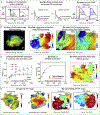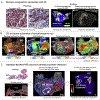Comprehensive evaluation of electrophysiological and 3D structural features of human atrial myocardium with insights on atrial fibrillation maintenance mechanisms
- PMID: 33130148
- PMCID: PMC7880876
- DOI: 10.1016/j.yjmcc.2020.10.012
Comprehensive evaluation of electrophysiological and 3D structural features of human atrial myocardium with insights on atrial fibrillation maintenance mechanisms
Abstract
Atrial fibrillation (AF) occurrence and maintenance is associated with progressive remodeling of electrophysiological (repolarization and conduction) and 3D structural (fibrosis, fiber orientations, and wall thickness) features of the human atria. Significant diversity in AF etiology leads to heterogeneous arrhythmogenic electrophysiological and structural substrates within the 3D structure of the human atria. Since current clinical methods have yet to fully resolve the patient-specific arrhythmogenic substrates, mechanism-based AF treatments remain underdeveloped. Here, we review current knowledge from in-vivo, ex-vivo, and in-vitro human heart studies, and discuss how these studies may provide new insights on the synergy of atrial electrophysiological and 3D structural features in AF maintenance. In-vitro studies on surgically acquired human atrial samples provide a great opportunity to study a wide spectrum of AF pathology, including functional changes in single-cell action potentials, ion channels, and gene/protein expression. However, limited size of the samples prevents evaluation of heterogeneous AF substrates and reentrant mechanisms. In contrast, coronary-perfused ex-vivo human hearts can be studied with state-of-the-art functional and structural technologies, such as high-resolution near-infrared optical mapping and contrast-enhanced MRI. These imaging modalities can resolve atrial arrhythmogenic substrates and their role in reentrant mechanisms maintaining AF and validate clinical approaches. Nonetheless, longitudinal studies are not feasible in explanted human hearts. As no approach is perfect, we suggest that combining the strengths of direct human atrial studies with high fidelity approaches available in the laboratory and in realistic patient-specific computer models would elucidate deeper knowledge of AF mechanisms. We propose that a comprehensive translational pipeline from ex-vivo human heart studies to longitudinal clinically relevant AF animal studies and finally to clinical trials is necessary to identify patient-specific arrhythmogenic substrates and develop novel AF treatments.
Keywords: Atrial fibrillation; Electrophysiology; Ex-vivo human heart; Fibrosis; Near-infrared optical mapping.
Copyright © 2020 Elsevier Ltd. All rights reserved.
Figures




Similar articles
-
Three-dimensional Integrated Functional, Structural, and Computational Mapping to Define the Structural "Fingerprints" of Heart-Specific Atrial Fibrillation Drivers in Human Heart Ex Vivo.J Am Heart Assoc. 2017 Aug 22;6(8):e005922. doi: 10.1161/JAHA.117.005922. J Am Heart Assoc. 2017. PMID: 28862969 Free PMC article.
-
Unmasking Arrhythmogenic Hubs of Reentry Driving Persistent Atrial Fibrillation for Patient-Specific Treatment.J Am Heart Assoc. 2020 Oct 20;9(19):e017789. doi: 10.1161/JAHA.120.017789. Epub 2020 Oct 2. J Am Heart Assoc. 2020. PMID: 33006292 Free PMC article.
-
Atrial fibrillation driver mechanisms: Insight from the isolated human heart.Trends Cardiovasc Med. 2017 Jan;27(1):1-11. doi: 10.1016/j.tcm.2016.05.008. Epub 2016 May 24. Trends Cardiovasc Med. 2017. PMID: 27492815 Free PMC article. Review.
-
Fibrosis and Atrial Fibrillation: Computerized and Optical Mapping; A View into the Human Atria at Submillimeter Resolution.JACC Clin Electrophysiol. 2017 Jun;3(6):531-546. doi: 10.1016/j.jacep.2017.05.002. Epub 2017 Jun 20. JACC Clin Electrophysiol. 2017. PMID: 29159313 Free PMC article. Review.
-
Atrial fibrillation driven by micro-anatomic intramural re-entry revealed by simultaneous sub-epicardial and sub-endocardial optical mapping in explanted human hearts.Eur Heart J. 2015 Sep 14;36(35):2390-401. doi: 10.1093/eurheartj/ehv233. Epub 2015 Jun 8. Eur Heart J. 2015. PMID: 26059724 Free PMC article.
Cited by
-
[Developments of ex vivo cardiac electrical mapping and intelligent labeling of atrial fibrillation substrates].Sheng Wu Yi Xue Gong Cheng Xue Za Zhi. 2024 Feb 25;41(1):184-190. doi: 10.7507/1001-5515.202211046. Sheng Wu Yi Xue Gong Cheng Xue Za Zhi. 2024. PMID: 38403620 Free PMC article. Review. Chinese.
-
Atrial fibrillation in cancer, anticancer therapies, and underlying mechanisms.J Mol Cell Cardiol. 2024 Sep;194:118-132. doi: 10.1016/j.yjmcc.2024.06.005. Epub 2024 Jun 17. J Mol Cell Cardiol. 2024. PMID: 38897563 Free PMC article. Review.
-
The association between left atrial appendage emptying velocity and atrial fibrillation recurrence after radiofrequency catheter ablation in patients with early persistent atrial fibrillation.BMC Cardiovasc Disord. 2024 Oct 1;24(1):529. doi: 10.1186/s12872-024-04215-0. BMC Cardiovasc Disord. 2024. PMID: 39354384 Free PMC article.
-
mTOR Modulation of IKr through hERG1b-Dependent Mechanisms in Lipotoxic Heart.Int J Mol Sci. 2022 Jul 22;23(15):8061. doi: 10.3390/ijms23158061. Int J Mol Sci. 2022. PMID: 35897638 Free PMC article.
-
The prognostic significance of left atrial appendage peak flow velocity in the recurrence of persistent atrial fibrillation following first radiofrequency catheter ablation.J Thorac Dis. 2021 Oct;13(10):5954-5963. doi: 10.21037/jtd-21-1363. J Thorac Dis. 2021. PMID: 34795943 Free PMC article.
References
-
- Nishida K, Nattel S, Atrial fibrillation compendium: historical context and detailed translational perspective on an important clinical problem, Circ. Res 114(9) (2014) 1447–1452. - PubMed
-
- Pedersen OD, Abildstrom SZ, Ottesen MM, Rask-Madsen C, Bagger H, Kober L, et al., Increased risk of sudden and non-sudden cardiovascular death in patients with atrial fibrillation/flutter following acute myocardial infarction, Eur Heart J 27(3) (2006) 290–5. - PubMed
-
- Ling LH, Kistler PM, Kalman JM, Schilling RJ, Hunter RJ, Comorbidity of atrial fibrillation and heart failure, Nat Rev Cardiol 13(3) (2016) 131–47. - PubMed
Publication types
MeSH terms
Grants and funding
LinkOut - more resources
Full Text Sources
Other Literature Sources
Medical
Research Materials

